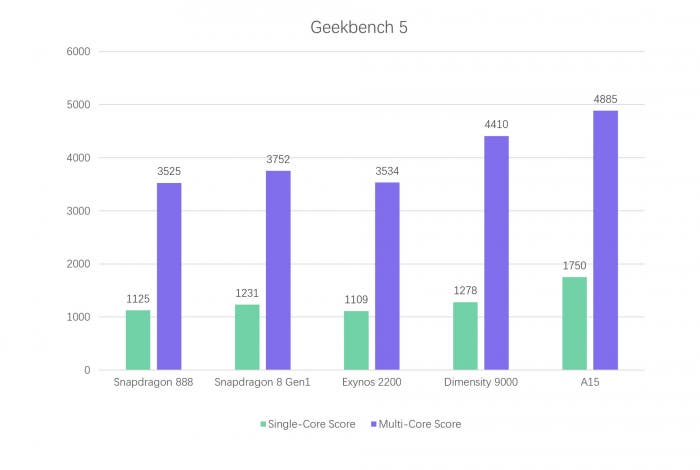Samsung has mastered the 4nm process and asked AMD to help build the graphics subsystem, and the result of all the efforts is the Exynos 2200 chip. The processor should debut in the Galaxy S22 series, which is due on February 9th. On paper, the chipset looks interesting, it remains to evaluate it in real operating conditions.
Exynos 2200 is even weaker than Snapdragon 888
Soon we will be able to assess the potential of the Exynos 2200, but not very encouraging information is roaming the net. So it could happen that the new Samsung processor will lose not only to the Snapdragon 8 Gen 1, but also to last year's Snapdragon 888 chipset. Ice Universe, a well-known and authoritative insider who published the results of the Exynos 2200 test in Geekbench 5; and compared the results obtained with Apple A15 Bionic, Dimensity 9000, Snapdragon 8 Gen 1 and Snapdragon 888.
According to the test results, the new flagship chipset Samsung lost to all competitors. Apple A15 Bionic was the most powerful of all, and Dimensity 9000 - in second place; leaving Snapdragon 8 Gen 1 behind. Ice Universe itself expressed regret that the Dimensity 9000; which will find its application in the Galaxy A series, will be more powerful than the Exynos 2200 installed in the Galaxy S22. It turns out that mid-range devices can be more powerful than the company's flagships.

Exynos 2200 with AMD graphics
As expected, Samsung's flagship platform features a new GPU based on the AMD RDNA 2 architecture found in the PlayStation 5, Xbox Series S and X consoles. The Exynos 2200 offers "the best mobile gaming experience"; thanks to the Xclipse 920 video accelerator, fresh Armv9 architecture; and an improved neural core (NPU) that doubles the performance of its predecessor. Thanks to the new graphics subsystem, the chip is "hybrid and one of a kind"; occupying an intermediate position between the processor for smartphones and the chip for game consoles.
The new Exynos 2200 processor and its Xclipse graphics accelerator support ray tracing and variable rate shading for smartphones; features that enhance the gaming experience and have so far only been available on PC, laptops and consoles. Samsung has confirmed that the Xclipse 920 GPU is only the first generation of several AMD RDNA GPUs that it plans to use for Exynos chipsets.
Ray tracing is a technology that mimics the behavior of light in the real world. By calculating the characteristics of the movement and color of light when it is reflected from surfaces; ray tracing creates realistic lighting effects for graphically rendered scenes. Variable Rate Shading is a technology that optimizes GPU load; allowing developers to use slower shading rates in areas that do not affect overall quality; thereby giving the GPU more room to work in the areas that gamers care most about and increasing frame rates for a smoother gaming experience.



